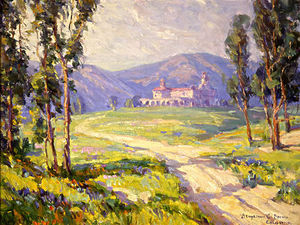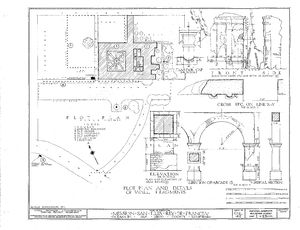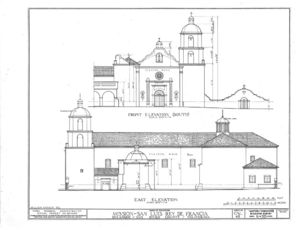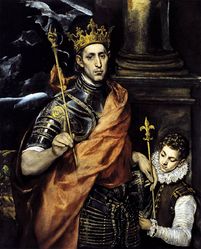Mission San Luis Rey de Francia/Gallery: Difference between revisions
imported>Robert A. Estremo No edit summary |
imported>Robert A. Estremo m (ital) |
||
| (12 intermediate revisions by the same user not shown) | |||
| Line 2: | Line 2: | ||
<gallery perrow=3 widths=300px heights=250px> | <gallery perrow=3 widths=300px heights=250px> | ||
Image:Fr. Antonio Peyri Departing - 1832.jpeg|{{Fr. Antonio Peyri Departing - 1832.jpeg/credit}}<br /> | Image:Kumeyaay.jpg|{{Kumeyaay.jpg/credit}}<br />During the Mission Period, natives occupying lands near Mission San Luis Rey de Francia were referred to as ''Luiseños'' by the Spaniards.<ref>Loumala, p. 592</ref> | ||
Image:Fr. Antonio Peyri Departing - 1832.jpeg|{{Fr. Antonio Peyri Departing - 1832.jpeg/credit}}<br />Fray Antonio Peyri departs Mission San Luis Rey in 1832. | |||
Image:Refusal to Work for Captain Portilla.jpg|{{Refusal to Work for Captain Portilla.jpg/credit}}<br />In 1833, Captain Pablo de la Portilla of San Diego was appointed ''comisionado'' (administrator) of Mission San Luis Rey. His heavy-handed administration caused considerable unrest. | Image:Refusal to Work for Captain Portilla.jpg|{{Refusal to Work for Captain Portilla.jpg/credit}}<br />In 1833, Captain Pablo de la Portilla of San Diego was appointed ''comisionado'' (administrator) of Mission San Luis Rey. His heavy-handed administration caused considerable unrest. | ||
Image:1844 Mission San Luis Rey de Francia.jpg|{{1844 Mission San Luis Rey de Francia.jpg/credit}}<br/>In 1841, [[France|French]] explorer [[Eugene Duflot de Mofras]] produced a sketch of the Mission that depicted a second ''[[campanario]]'', thereby supporting the theory that two bell towers were planned, but never completed; the lone tower was also used as a lookout post.<ref>Krell, pp. 275-276</ref> | Image:1844 Mission San Luis Rey de Francia.jpg|{{1844 Mission San Luis Rey de Francia.jpg/credit}}<br/>In 1841, [[France|French]] explorer [[Eugene Duflot de Mofras]] produced a sketch of the Mission that depicted a second ''[[campanario]]'', thereby supporting the theory that two bell towers were planned, but never completed; the lone tower was also used as a lookout post.<ref>Krell, pp. 275-276</ref> | ||
Image:Mission of San Luis Rey de Francia Dwinelle 1866.jpg|{{Mission of San Luis Rey de Francia Dwinelle 1866.jpg/credit}}<br />An 1866 rendering of Mission San Luis Rey de Francia depicts a single bell tower crafted in a distinctly different architectural style than that which exists today. | |||
Image:San Luis Ray Mission by Alexander Harmer.jpg|{{San Luis Ray Mission by Alexander Harmer.jpg/credit}}<br />Mission San Luis Rey de Francia as it stood in 1892. | |||
Image:Alexander Harmer Garden of the Mission San Luis Rey.jpg|{{Alexander Harmer Garden of the Mission San Luis Rey.jpg/credit}}<br />The garden at Mission San Luis Rey. | |||
Image:Interior of Mission San Luis Rey de Francia circa 1893.jpg|{{Interior of Mission San Luis Rey de Francia circa 1893.jpg/credit}}<br/>The interior of Mission San Luis Rey de Francia before restoration, ''circa'' 1893. | Image:Interior of Mission San Luis Rey de Francia circa 1893.jpg|{{Interior of Mission San Luis Rey de Francia circa 1893.jpg/credit}}<br/>The interior of Mission San Luis Rey de Francia before restoration, ''circa'' 1893. | ||
Image:San Luis Rey de Francia circa 1900 Keystone-Mast Company.jpg|{{San Luis Rey de Francia circa 1900 Keystone-Mast Company.jpg/credit}}<br/>Inside the "cavernous" ''capilla'' (chapel) at Mission San Luís Rey de Francia, ''circa'' 1900. Dedicated in 1815, the cruciform design is shared only with the ruined "Great Stone Church" at [[Mission San Juan Capistrano]], making the two structures unique among the Alta California missions in that regard.<ref>Krell, pp. 154, 275</ref> | Image:San Luis Rey de Francia circa 1900 Keystone-Mast Company.jpg|{{San Luis Rey de Francia circa 1900 Keystone-Mast Company.jpg/credit}}<br/>Inside the "cavernous" ''capilla'' (chapel) at Mission San Luís Rey de Francia, ''circa'' 1900. Dedicated in 1815, the cruciform design is shared only with the ruined "Great Stone Church" at [[Mission San Juan Capistrano]], making the two structures unique among the Alta California missions in that regard.<ref>Krell, pp. 154, 275</ref> | ||
Image:CHS-2097.jpg|{{CHS-2097.jpg/credit}}<br/>Mission San Luis Rey de Francia is home to with the first Peruvian Pepper Tree (''[[Schinus molle]]'') planted in California in 1830, visible at right behind the arches in the above photograph (taken ''circa'' 1900). | Image:CHS-2097.jpg|{{CHS-2097.jpg/credit}}<br/>Mission San Luis Rey de Francia is home to with the first Peruvian Pepper Tree (''[[Schinus molle]]'') planted in California in 1830, visible at right behind the arches in the above photograph (taken ''circa'' 1900).<ref>Young, p. 18</ref> | ||
Image:San Luis Rey de Francia circa 1910 William Amos Haines.jpg|{{San Luis Rey de Francia circa 1910 William Amos Haines.jpg/credit}}Mission San Luis Rey de Francia, ''circa'' 1910. | Image:San Luis Rey de Francia circa 1910 William Amos Haines.jpg|{{San Luis Rey de Francia circa 1910 William Amos Haines.jpg/credit}}Mission San Luis Rey de Francia, ''circa'' 1910. | ||
Image:Choir missals at Mission San Luis Rey.jpg|{{Choir missals at Mission San Luis Rey.jpg/credit}}<br/>Illuminated choir missals on display at Mission San Luis Rey de Francia in 1913.<ref>James, p. 215</ref> | Image:Choir missals at Mission San Luis Rey.jpg|{{Choir missals at Mission San Luis Rey.jpg/credit}}<br/>Illuminated choir missals on display at Mission San Luis Rey de Francia in 1913.<ref>James, p. 215</ref> | ||
Image: | Image:Benjamin Brown The Mission.jpg|{{Benjamin Brown The Mission.jpg/credit}}<br />"The Mission," ''circa'' 1915. | ||
Image:Mission SLR plot plan.jpg|{{Mission SLR plot plan.jpg/credit}}<br />A plot plan drawing and details of the Mission San Luís Rey de Francia complex as prepared by the U.S. Historic American Buildings Survey in 1937. | |||
Image:Mission SLR floor plan.jpg|{{Mission SLR floor plan.jpg/credit}}<br />A floor plan drawing of the Mission San Luís Rey de Francia complex as prepared by the U.S. Historic American Buildings Survey in 1937. | |||
Image:Mission SLR clerestory plan.jpg|{{Mission SLR clerestory plan.jpg/credit}}<br />A clerestory plan drawing of the Mission San Luís Rey de Francia complex as prepared by the U.S. Historic American Buildings Survey in 1937. | |||
Image:Mission SLR elevations.jpg|{{Mission SLR elevations.jpg/credit}}<br />An elevation drawing of Mission San Luís Rey de Francia as prepared by the U.S. Historic American Buildings Survey in 1937. | |||
Image:Mission San Luis Rey de Francia current.jpg|{{Mission San Luis Rey de Francia current.jpg/credit}}<br />Mission San Luis Rey de Francia (seen here in 1986) is architecturally distinctive due to the combination of Spanish, Moorish, and Mexican lines exhibited. Part of California's most pristine mission complex, the baroque façade of the church was meant to be flanked by twin towers. | |||
Image:Mission San Luis Rey chapel interior.jpg|{{Mission San Luis Rey chapel interior.jpg/credit}}<br />The chapel interior at Mission San Luis Rey in 2005. | |||
Image:Mission San Luis Rey courtyard arch.jpg|{{Mission San Luis Rey courtyard arch.jpg/credit}}<br />A view through the courtyard arch at Mission San Luis Rey in March of 2005. | |||
Image:USNS Mission San Luis Rey.jpg|{{USNS Mission San Luis Rey.jpg/credit}}<br/>[[USNS Mission San Luis Rey (T-AO-128)|USNS ''Mission San Luis Rey'' (T-AO-128)]] at anchor in the Long Beach / San Pedro, California area. | |||
Image:Saint Louis IX (1214-1270).jpg|{{Saint Louis IX (1214-1270).jpg/credit}}<br />Saint Louis IX of France, patron of arts and arbiter of Europe. | Image:Saint Louis IX (1214-1270).jpg|{{Saint Louis IX (1214-1270).jpg/credit}}<br />Saint Louis IX of France, patron of arts and arbiter of Europe. | ||
</gallery> | </gallery> | ||
==Notes== | ==Notes and references== | ||
{{reflist}} | {{reflist|2}} | ||
Latest revision as of 12:56, 28 May 2015
(PD) Engraving: Schott, Sorony, and Co.
During the Mission Period, natives occupying lands near Mission San Luis Rey de Francia were referred to as Luiseños by the Spaniards.[1](PD) Drawing: Eugene Duflot de Mofras
In 1841, French explorer Eugene Duflot de Mofras produced a sketch of the Mission that depicted a second campanario, thereby supporting the theory that two bell towers were planned, but never completed; the lone tower was also used as a lookout post.[2](PD) Photo: Keystone-Mast Company
Inside the "cavernous" capilla (chapel) at Mission San Luís Rey de Francia, circa 1900. Dedicated in 1815, the cruciform design is shared only with the ruined "Great Stone Church" at Mission San Juan Capistrano, making the two structures unique among the Alta California missions in that regard.[3](PD) Photo: Charles C. Pierce
Mission San Luis Rey de Francia is home to with the first Peruvian Pepper Tree (Schinus molle) planted in California in 1830, visible at right behind the arches in the above photograph (taken circa 1900).[4](PD) Photo: George Wharton James
Illuminated choir missals on display at Mission San Luis Rey de Francia in 1913.[5]© Photo: Robert A. Estremo
Mission San Luis Rey de Francia (seen here in 1986) is architecturally distinctive due to the combination of Spanish, Moorish, and Mexican lines exhibited. Part of California's most pristine mission complex, the baroque façade of the church was meant to be flanked by twin towers.(PD) Photo: Dick Markell / United States Navy
USNS Mission San Luis Rey (T-AO-128) at anchor in the Long Beach / San Pedro, California area.
![(PD) Engraving: Schott, Sorony, and Co. During the Mission Period, natives occupying lands near Mission San Luis Rey de Francia were referred to as Luiseños by the Spaniards.[1]](/wiki/images/thumb/7/78/Kumeyaay.jpg/230px-Kumeyaay.jpg)


![(PD) Drawing: Eugene Duflot de Mofras In 1841, French explorer Eugene Duflot de Mofras produced a sketch of the Mission that depicted a second campanario, thereby supporting the theory that two bell towers were planned, but never completed; the lone tower was also used as a lookout post.[2]](/wiki/images/thumb/0/0c/1844_Mission_San_Luis_Rey_de_Francia.jpg/300px-1844_Mission_San_Luis_Rey_de_Francia.jpg)




![(PD) Photo: Keystone-Mast Company Inside the "cavernous" capilla (chapel) at Mission San Luís Rey de Francia, circa 1900. Dedicated in 1815, the cruciform design is shared only with the ruined "Great Stone Church" at Mission San Juan Capistrano, making the two structures unique among the Alta California missions in that regard.[3]](/wiki/images/thumb/3/30/San_Luis_Rey_de_Francia_circa_1900_Keystone-Mast_Company.jpg/238px-San_Luis_Rey_de_Francia_circa_1900_Keystone-Mast_Company.jpg)
![(PD) Photo: Charles C. Pierce Mission San Luis Rey de Francia is home to with the first Peruvian Pepper Tree (Schinus molle) planted in California in 1830, visible at right behind the arches in the above photograph (taken circa 1900).[4]](/wiki/images/thumb/f/fa/CHS-2097.jpg/199px-CHS-2097.jpg)

![(PD) Photo: George Wharton James Illuminated choir missals on display at Mission San Luis Rey de Francia in 1913.[5]](/wiki/images/thumb/7/7b/Choir_missals_at_Mission_San_Luis_Rey.jpg/300px-Choir_missals_at_Mission_San_Luis_Rey.jpg)









